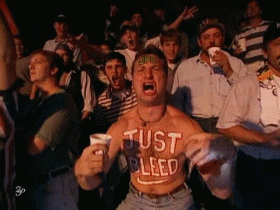- Joined
- Dec 2, 2015
- Messages
- 2,274
- Reaction score
- 361
Yes. I tend to think the correct winner would be identified through a larger pool of scorecards instead of just 3.

Only way to get best results, scoring wise.
Yes. I tend to think the correct winner would be identified through a larger pool of scorecards instead of just 3.
A great idea would be to let fans decide via a real-time app.Nah, fuq dat
No judges, no time limits, like back in da early days

Assuming that is something we see in the future, wouldn't it still be helped by additional eyes/scorecards being used to give decisions?Imo the judges need to be given more scale to work with and to actually use it.
I want to see 10-10, 10-7 and 10-6 being scored.
10-9 is currently used for everything from a coin flip to anything just shy of a complete beatdown.
Assuming that is something we see in the future, wouldn't it still be helped by additional eyes/scorecards being used to give decisions?
Yes. Reduces the influence of a bad judge from 33% to 20%.
I believe the best way to ameliorate the prevalence of bad decisions is evidence based judging. It can be implemented in the following way:
1 person in the truck presses a button every time they believe a strike may have landed. A slow motion clip of the preceding 1/2 second in patched through in real time to two judges who rate the efficacy of the strike on a 1-10 scale. 1 for an insignificant glancing blow and 10 for a flush, heavy, knockdown type blow. The scores are added, then halved and submitted to a third judge at the end of the round.
The third judge, who during the round scores the fighters on a 1-20 scale for octagon control and aggressiveness adds the cumulative score for the strikes landed to their OC&A score which can be adjusted based on situations where strikes that appeared to land well did not.
A fourth judge scores the grappling exchanges if they are present. For each pass, advance or period of control, fighters receive a score adjusted to the length of time spent grappling vs the length of time spent striking. e.g. In a fight where grappling exchanges consist of 2/3's of the round, the scores will be doubled in relation to the striking scores. as they consisted of 67% of the fight vs 33%.
Lastly, a fifth judge views the grappling and striking exchanges and gives a weighting based on which type of attack was most significant in the round and that weighting is then multiplied by the scores given by the other 4 judges. e.g. In a fight where fighter A score 30 for striking and 10 for grappling, and fighter B scores 10 for striking and 20 for grappling, but the fifth judges views the grappling exchanges to be twice as significant as the striking exchanges, the scores will be adjusted so fighter A ends up with 15 for striking and 20 for grappling (35) and fighter B scores 5 for striking and 60 for grappling (45).
This is a very small and heavily simplified snapshot of the algorithm I developed for part of my masters dissertation. I am prepared to engage conversation about it if anyone is interested.
Rounds are scored according to the existing 10 point must system with differences of 30% or more (with a 50 point total minimum) resulting in a 10-8 round and 70% or more (with a 70 point minimum) a 10-7 round.
I have used my algorithm to score 17 controversial judging decisions in development, with all 17 decisions being corrected to the majority public consensus.
There would be less bad decisions if rounds were 10 min + 5 min like in PRIDE. More finishes.
Have the judges publish their scores after each round.
I miss soccer kicks too...Their ruleset in general was better, IMO.
Juust add elbow strikes, and it's perfection.

